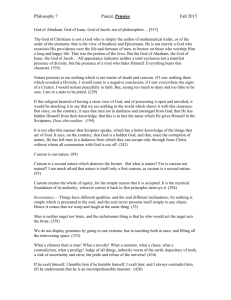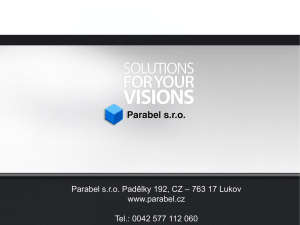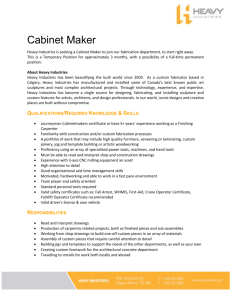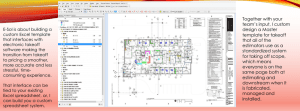Putting the case for custom power supplies in low to
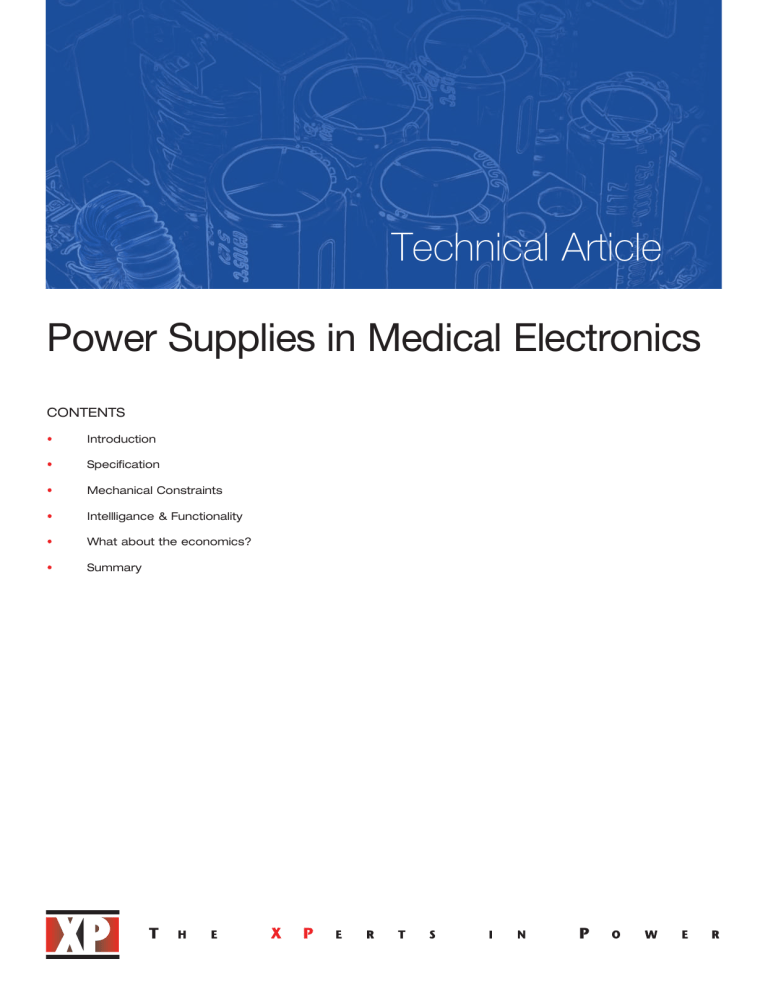
Technical Article
Power Supplies in Medical Electronics
•
•
•
•
•
CONTENTS
• Introduction
Specification
Mechanical Constraints
Intellligance & Functionality
What about the economics?
Summary
xppower.com
Introduction
If there is one facet of the power supply business that has seen rapid growth over the last 10 years, it is that of configurable power. A standard input circuit and chassis is customised with plug-in modules to deliver the nearest requirement to the customer specification. This approach has a lot to be said for it and a great deal has been written about its benefits. However, somewhere along the line, the perception has evolved that full custom power solutions are expensive, risky, only suited to very high volumes, and can only be completed after months or even years of painstaking design work.
This article sets out to redress the balance, and to consider what custom power has to offer companies with low to medium volume requirements, companies that need to achieve the lowest cost power solution, and those simply wanting to avoid any kind of design compromise.
The specification you need, not the specification that happens to be available
Of course, the main attraction of a custom power supply is that it is designed to be the optimum fit for the application. That means it’s the right size, the right shape, and has ideal inputs and outputs, both in terms of electrical and mechanical specifications. In fact, using a custom power supply is a way of differentiating the end product, perhaps ensuring competitive advantage that will lead to improved system performance, appearance and even better sales prospects. Custom power is often used for high-volume products like PCs and electronic consumer goods where development costs can be amortised over a large number of units. However, it can be equally applicable to industrial, military, medical and commercial applications that have lower volume requirements and quantities of as little as 30 units per annum can be commercially viable. Most importantly, a full custom power supply can be the most cost-effective solution, even in small quantities, when you consider that there is no need to over-specify the unit in terms of power rating and no need to pay for functionality that’s not required.
Fig 1. The DX 9A is a custom designed charger for a portable radio MRR 9M (Multi Role Radio) for the Ministry of Defence in Norway. The charger is placed between the radio and a NiCa or Lithium battery.
Mechanical constraints often drive demand for custom power
One of the most common drivers for the custom power supply business is the need to meet unique mechanical requirements. It is still very common for an electronic system to be developed using a bench power supply only to find that there is insufficient space for a standard power unit of the required electrical performance when the main design is completed. Of course, it is not always possible to solve the problem with a custom power supply, but the approach does offer great flexibility. For example, there is no rulebook that states that a power supply should be an oblong or cubic box, or based on rectangular PCBs. It can be any shape necessary to fit the available space, providing that electrical performance and EMC requirements can be maintained and heat can be removed effectively. In addition, because a custom PCB will be designed for each custom power supply, it is sometimes advantageous to include additional circuitry on the same board, freeing up space on other system boards. This design flexibility means that the value of the solution needs to be considered based on the system as a whole, not just viewing things in the traditional way. A further advantage is that if the power supply is visible to users of the end system it can be designed to match the required appearance in terms of colour, panel labelling and status indicators. Finally, the ideal input/output connectivity methods can be specified for each system, making final product assembly easier, or perhaps facilitating easier maintenance and hot-swap capabilities.
2
xppower.com
As power supplies become more intelligent functionality becomes more complex
As electronic systems become more complex, so do the demands on power supplies. Remote sense, sophisticated control and monitoring, circuit protection, alarm indications and a host of other features are needed to keep systems running optimally and to ensure the appropriate response to fault conditions. With a custom design, these can all be specified to meet exact system requirements with no wastage and optimised performance.
Input and output circuit conditioning can be designed to meet the specific conditions under which the power supply will operate. For example, sequencing of custom-specified output voltages can be tailored to the application, something that is rarely possible using even the most advanced configurable power supplies. Customised input circuits not only take account of required voltage rating, but can also be designed for specific power factor, EMC, inrush current and fault condition responses.
Fig 2. The PP-210N is a UPS with two 12 V 14 Ah batteries to charge 24 V batteries in a vehicle or from a service charger also developed by CB Svendsen a/s
What about the economics?
It is a myth that every custom power supply costs thousands of Euros in up-front engineering costs and takes many months to develop. It really depends on the design complexity and the clarity of the brief provided to the power supply vendor. An established vendor will have hundreds of design elements in CAD ready to be included in new designs and will have experience in meeting the most common requirements. Furthermore, if the custom power supply vendor has all major design and manufacturing capabilities in-house, they are likely to be able to deliver a much faster and more flexible service for small to medium volume production runs than those companies that sub-contract many of these activities.
Although complex and evolving power system designs can take months, a simple design can be sometimes be completed in as little as a week.
Designs that use standard modules within customised enclosures, perhaps with additional input, output or control circuits can also be developed quite quickly in most instances.
Where a full custom product is needed, design and development costs typically start from around $10,000 but can occasionally be even less than this.
Furthermore, these costs do not always have to be paid in advance but can be amortised, at least in part, across the price of power supplies produced over an agreed period of time. This minimises risk and improves cash flow for customers. As mentioned earlier, quantities as small as 30 units per year can be economical. At this volume, component costs will probably be 30-40% of the final price. For higher volumes, say 5000 units, component costs are typically nearer 80% of the final price, so custom design does become more economical as volumes increase.
A further advantage of the full custom design route is that security against obsolescence can be negotiated at the outset of the contract. Guaranteed availability for 10 years or more can be agreed and this can eliminate the need for customers to hold back-up inventory as insurance against a standard unit being made obsolete.
Summary
It’s true that full custom power supplies can be expensive to develop and can involve extended development times. However, this is not always the case. It is always worth exploring the full custom option, even for modest production runs. When the real cost-of-ownership is considered, the economics can be attractive and the desirability of using a power supply that exactly fits the mechanical, electrical and aesthetic demands of an electronic system should never be ignored in favour of a quick decision to use an off-the-shelf, compromise power unit.
3
North American HQ
XP Power
990 Benecia Avenue, Sunnyvale, CA 94085
Phone : +1 (408) 732-7777
Fax : +1 (408) 732-2002
Email : nasales@xppower.com
North American Sales Offices
Toll Free.........................+1 (800) 253-0490
Central Region ...............+1 (972) 578-1530
Eastern Region ............+1 (973) 658-8001
Western Region .............+1 (408) 732-7777
European HQ
XP Power
Horseshoe Park, Pangbourne,
Berkshire, RG8 7JW, UK
Phone : +44 (0)118 984 5515
Fax : +44 (0)118 984 3423
Email : eusales@xppower.com
European Sales Offices
Austria ........................+41 (0)56 448 90 80
Belgium .....................+33 (0)1 45 12 31 15
Denmark ..........................+45 43 42 38 33
Finland ........................+46 (0)8 555 367 01
France ......................+33 (0)1 45 12 31 15
Germany ....................+49 (0)421 63 93 3 0
Italy ................................+39 039 2876027
Netherlands ...............+49 (0)421 63 93 3 0
Norway .............................+47 63 94 60 18
Sweden ..................... +46 (0)8 555 367 00
Switzerland ................ +41 (0)56 448 90 80
United Kingdom .........+44 (0)118 984 5515
German HQ
XP Power
Auf der Höhe 2, D-28357
Bremen, Germany
Phone : +49 (0)421 63 93 3 0
Fax : +49 (0)421 63 93 3 10
Email : desales@xppower.com
Global Catalog Distributors
Americas ........................................Newark
newark.com
Europe & Asia ...................................Farnell
farnell.com
China ............................Premier Electronics premierelectronics.com.cn
Asian HQ
XP Power
401 Commonwealth Drive, Haw Par Technocentre, Lobby B,
#02-02, Singapore 149598
Phone : +65 6411 6900
Fax
Web
: +65 6741 8730
: apsales@xppower.com
: www.xppowerchina.com / www.xppower.com
Asian Sales Offices
Shanghai ....................... +86 21 51388389
Singapore .......................... +65 6411 6902
Distributors
Australia ..........................+61 2 9809 5022 Amtex
Balkans ...........................+386 1 583 7930 Elbacomp
Czech Rep . ...................+420 235 366 129 Vums Powerprag
Czech Rep . ...................+420 539 050 630 Koala Elektronik
Estonia ................................+372 6228866 Elgerta
Greece ..........................+30 210 240 1961 ADEM Electronics
Israel ................................+972 9 7498777 Appletec
Japan ..............................+81 48 864 7733 Bellnix
Korea ..............................+82 31 422 8882 Hanpower
Latvia ................................+371 67501005 Caro
Lithuania ...........................+370 5 2652683 Elgerta
Poland ..............................+48 22 8627500 Gamma
Portugal ..........................+34 93 263 33 54 Venco
Russia ...........................+7 (495)234 0636 Prosoft
Russia ...........................+7 (812)325 5115 Gamma
South Africa .....................+27 11 453 1910 Vepac
Spain ..............................+34 93 263 33 54 Venco
Taiwan ..............................+886 3 3559642 Fullerton Power
Turkey ...........................+90 212 465 7199 EMPA
Feb 04


